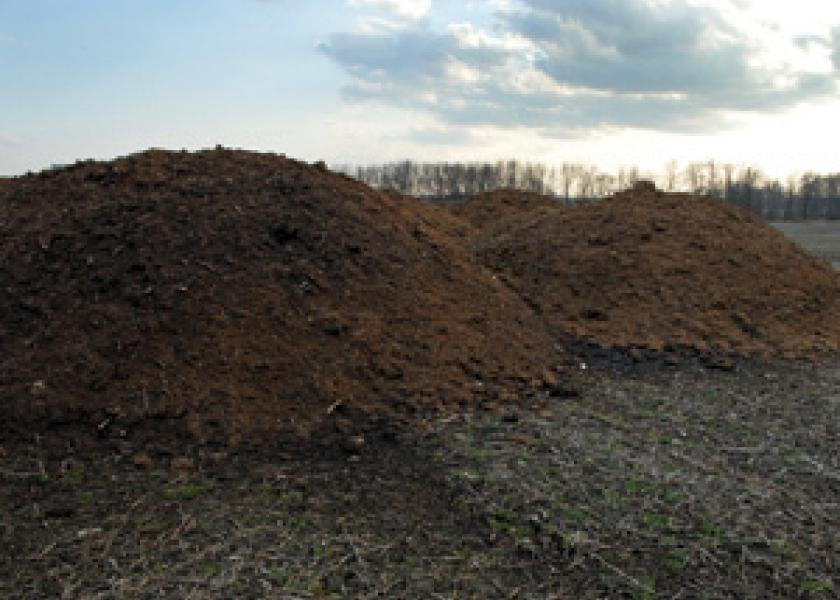Manure Management Concerns Caused By Recent Wet Weather

By Angela Rieck-Hinz and Daniel Andersen, Iowa State University
The wet spring has raised many concerns about manure management for Iowa crop and livestock farmers. The following is a quick list of issues and possible responses to the issues. Farmers are encouraged to contact their local Extension and Outreach ag engineer, field agronomist or livestock specialist, or the local DNR field office for additional information and assistance.
Delayed Planting
As we approach June, many areas of the state have experienced delays in corn planting due to wet soil conditions. Those fields that have had liquid manure applied at rates intended for growing corn can be switched to soybean on or after June 1 with no penalty of over-application of manure nitrogen. Chapter 65 of the Iowa Administrative Code reads [65.17(18)c]
"Nitrogen-based application rates shall be based on the optimum crop yields as determined in 65.17(6) and crop nitrogen usage rate factor values in Table 4 at the end of this chapter or other credible sources. However, subject to the prohibition in 65.17(20), liquid manure applied to land that is currently planted to soybeans or to land where the current crop has been harvested and that will be planted to soybeans the next crop season shall not exceed 100 pounds of available nitrogen per acre. Further, the 100 pounds per acre application limitation in the previous sentence does not apply on or after June 1 of each year; in that event 65.17(6) and Table 4 would apply as provided in the first sentence of this paragraph."
Producers should document the changes in the crop rotation, application methods and other changes in their annual manure management plan forms, prior to planting or changes in application method.
Application of Nitrogen
Although in many areas of Iowa it will be days if not weeks before farmers can get back in the field to finish planting or to replant, for many of the planted fields a concern will be nitrogen loss. Livestock producers with DNR manure management plans are reminded that if they have already applied the maximum nitrogen rate to the field, they can’t apply additional sources of nitrogen unless the need is confirmed by the use of the late spring nitrate test (LSNT). This test measures nitrate-N concentration at the 0-12 inch depth. Be sure to read the recent article on nitrogen issues by Jeremy Klatt, DNR, if you have a manure or nutrient management plan.
Manure Storage
During wet water our primary management goal should be to keep concentrated manure contained. Open manure storages should be monitored closely to prevent these structures from over-topping. If manure levels in storage ponds or tanks approaches full capacity producers should make plans to remove manure from these structures. The over-topping of bermed earthen storage ponds and lagoons could result in breaching and loss of the structures. Although concrete and steel structures are not in danger of breach failures, they should also have level removed if they are in danger of overtopping.
Producers should transfer manure from full storage structures to alternative storages if available, as land application of manures during saturated conditions is likely to result in movement of manure nutrient and organic matter into surface waters. If no alternative manure storage is available producers should contact the Iowa Department of Natural Resources to discuss emergency wet-weather land application before allowing a storage tank or pond to overflow. If manure levels reach one foot below the top of a concrete or steel structure, or within two feet of the top of an earthen bermed structures producers should contact their local Iowa DNR field office.
Contact Information for IDNR Field Offices
Field Office # 1 - Manchester (563) 927-2640
Field Office # 2 - Mason City (641) 424-4073
Field Office # 3 - Spencer (712) 262-4177
Field Office # 4 - Atlantic (712) 243-1934
Field Office # 5 - Des Moines (515) 725-0268
Field Office # 6 - Washington (319) 653-2135
Land application challenges
Wet soils intake manures and water at a slower rate, much of their capacity to hold liquids is already used, and they are prone to compaction and surface runoff. Moving manure to available storages is thus preferable, but if no alternative storage can be identified and emergency manure application must be performed, contact your Iowa Department of Natural Resources field office.
Tips to consider include:
Haul a few loads to lighter, well-drained soils that may support manure application equipment.
If using tankers consider filling them to less than full capacity to limit weight.
To minimize the risk of nutrient transport, avoid fields with a high risk of runoff or flooding, consider applying to the driest portions of fields, and reduce the manure application rate.
Apply to fields with flatter slopes and lower phosphorus index scores and try to apply at least 24 hours before substantial rainfall to help prevent runoff.
If this doesn’t follow your manure management plan, be sure to update the plan accordingly.
Develop and/or review your emergency application plan. Wet weather and muddy conditions increase the chances for something to go wrong and can slow response. Review the emergency response plan with employees. Emphasize who to contact, safety issues and what to do when emergencies occur. Potential issues to discuss include how to contain the spill, who to contact (both within the company and the appropriate agencies) and how to perform the clean-up and the necessary repairs. If possible a copy of these resources should be placed in the tractor.







